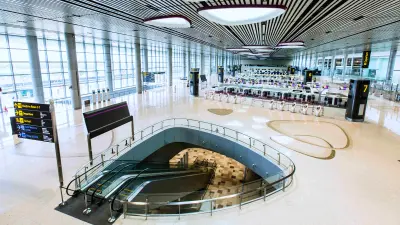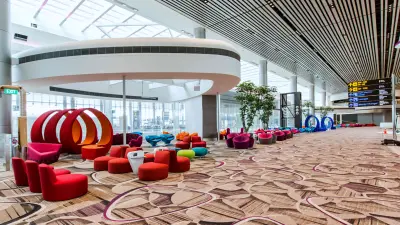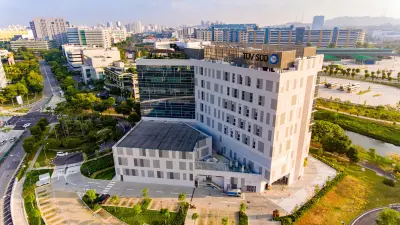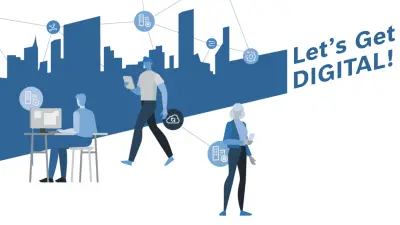Sending out a clear message
As one of the most popular airports in the world, Changi Airport in Singapore regularly tops passenger surveys. Bosch has helped the airport maintain its excellent reputation; this is where its team in Singapore implemented its biggest public address system to date.

Investing in safety and reputation
Changi Airport is one of the most important transportation hubs for air passengers in Asia. About 7,200 flights depart from and land there every week, while roughly 62 million people pass through its gates every year. Coordinating all this is no mean feat, particularly when you consider that Changi Airport Group puts great emphasis on creating an atmosphere in which passengers feel comfortable and safe. But if passenger surveys are anything to go by, it has clearly outdone itself: Changi Airport was voted the world’s best airport for the sixth time in a row in 2018.
Changi Airport Group has been investing in its infrastructure to maintain its excellent reputation. When several modernization projects were on the horizon, the team at Robert Bosch Southeast Asia participated in updating the safety technology in the three airport terminals. Eventually the Changi Airport Group decided a few years ago to construct a fourth terminal. After a tender process, the contract was awarded to Takenaka, a construction, engineering and architecture firm, which proposed Bosch’s safety expertise to join the project.
Sound systems in 150 zones
A major contract was assigned to the team of Bosch Energy and Building Solutions in Singapore. The team planned and installed a solution consisting of over 3,500 loudspeakers, working on the project from the beginning of construction work in 2014 to the opening of Terminal 4 in October 2017. It was the biggest project that the Bosch safety experts had carried out with the Praesideo public address and voice alarm system up to that point. As had been the case two years previously, a customized solution that would meet the client’s high requirements was needed. Even before construction had begun, it was determined that 16 million passengers would pass through Terminal 4. A huge crowd of people is therefore spread out daily over a large area.
Accordingly, there are also a large number of public address zones: “There are 150 in total, which is about 20 times more than for the projects we usually carry out,” says systems engineer Jimmy Tan. He was involved in developing the system and optimizing it on-site. 21 departure gates and eight bus gates, arrival and departure halls, duty-free shops, and many more indoor spaces are numbered among these 150 zones. The first experts from Bosch arrived in summer 2014, a few months after construction work for Terminal 4 had begun, and took part in weekly meetings with architects and consultancies involved in the project. Their main work finally began in 2016, when the team developed a unique public address concept and worked in close collaboration with the commissioned construction companies during installation.
3,500 loudspeakers
were installed for the public address and voice alarm system in Terminal 4.
Voice alarm system with redundancy

“Because the voice alarm system is an element of the airport’s infrastructure that is crucial to passenger safety, we designed it as redundant from the very beginning,” says Jimmy. The Praesideo system was housed in four different rooms; three of these are located in the terminal, while the other was in the airport tower. Praesideo ring systems, which consist of network controllers, amplifiers, switches, and different interface devices, among other pieces of equipment, are now installed in each room. Furthermore, the team from Bosch also planned and provided support for the installation of fireproof loudspeaker cables, which was carried out by the CISS (Commercial Industrial Supplies & Services) Pte. Ltd., in order to comply with strict fire safety regulations. A management system monitors the technical processes in the background to ensure that they run faultlessly. The experts from Bosch opted for a solution from ICAS (Industrial Computerisation and Automation System) Technology (S) Pte. Ltd., a company from Singapore. This software-based solution offers additional safety.
The status monitoring system continuously monitors the Praesideo system’s status and displays it on the monitors located at the fault management center and equipment room. Thus it becomes easier for the maintenance staff to see the system’s health status at one glance.
Ensuring consistent acoustics - it's all in the mix
Acoustics proved to be the biggest challenge in installing the loudspeakers. The team from Bosch had to ensure consistent acoustics, despite the combination of bare marble walls and sound-absorbing carpet floors in the airport’s expansive halls. They managed to solve this problem by opting for a mixture of the loudspeakers: They installed different versions of a particular type of loudspeaker on the columns that directs sound towards the ears of visitors to the airport. The team worked in close collaboration with the architects and ensured that the loudspeakers fit in with their environment from both a technical and an aesthetic standpoint. Therefore it installed different ceiling loudspeakers in the corridors and adjacent shops, which, in line with the client’s wishes, either offered outstanding sound quality or served as reasonably priced all-rounders, depending on their position in the terminal.

“We also installed high-frequency add-ons at various points, where the sound needs to be projected the furthest. They doubled the range of the column loudspeakers to 50 meters.”
Smooth system integration - staying on the safe side
The experts from Bosch had to factor in converters and network switches from third-party suppliers that had already been installed when planning the new Praesideo system. A test center of sorts was set up to ensure that the Bosch solution would work with the systems on-site from the offset. The team purchased a few examples of the third-party devices in place, set them up in its offices, and tested them to see whether they would work with the Praesideo system. “By doing so, we were able to rule out unpleasant surprises and disruptions in advance,” explains Jimmy.
Their preparation work paid off in the end – system integration during the installation at Terminal 4 went off without a hitch. The system has been in use for over a year now, and guarantees excellent acoustics in Terminal 4: Announcements are clear and easy to understand, no matter where you are in the terminal. Meanwhile, the personnel at information counters have benefitted from the fact that the system is easy to use. This ensures that all workflows behind the scenes and in the airport run seamlessly.


